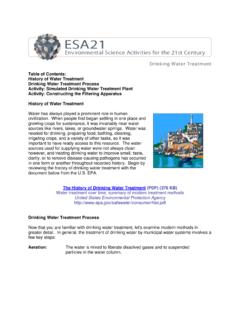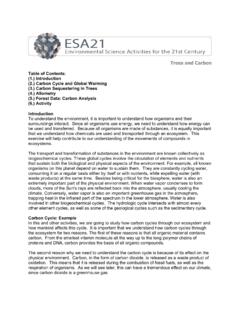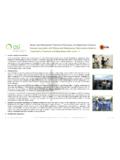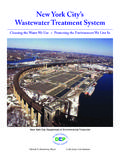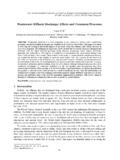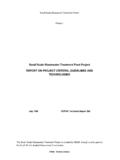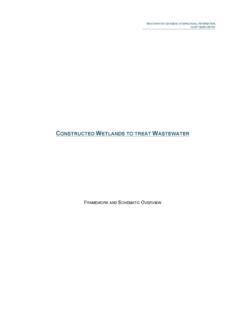Transcription of Wastewater Treatment - Kennesaw State University
1 Wastewater Treatment Table of Contents: (1.) Wastewater Treatment Basics (2.) Activity: Wastewater Treatment Plant Virtual Tour Wastewater Treatment Basics When you think about the variety of materials that enter the Wastewater system from a typical home, the list is diverse and extensive: wastes from toilets; soap, detergents, and cleaning products from drains and washing machines; food items from garbage disposals - all along with large quantities of water. How is this material removed so that the water may be safely returned to the environment and, possibly, utilized again by other people downstream?
2 The answer depends on where you live. If your home is not serviced by a public sewer system, your wastes are undoubtedly treated with a septic system. In this system, wastes are shuttled from the home into an underground storage tank. Sludge in the Wastewater sinks to the bottom of the tank, oils float, and the water in between the two layers is dispersed into the surrounding soil through a network of pipes. The tank must be emptied on a regular basis, and the system properly maintained to ensure proper operation over time. If your home is serviced by a public sewer system, the process is roughly the same but on a larger scale.
3 Wastewater leaves your residence and is piped to a Wastewater Treatment facility, where it is run through a series of steps to clean the water prior to release into a creek, river, lake, or ocean. The first steps are collectively known as preliminary Treatment , in which large objects are removed from the water stream with screens and large particles settle out as the flow rate of the water is reduced. In primary Treatment , the Wastewater is funneled into large holding tanks (sedimentation tanks) and left undisturbed to allow heavy particles to sink out, and greases and oils to rise to the surface.
4 The material on the top and bottom of the tanks is skimmed away, and the water proceeds on to secondary Treatment . In this stage, bacteria are introduced and they begin consuming the small particles of organic matter that remain in the water. To facilitate this, oxygen is pumped into the water to allow the bacteria to feed continuously, as low oxygen levels cause feeding rates to slow. The water then flows into another set of settling tanks, where most of the bacteria settle out and are pumped back into the aeration tanks. The water is then chlorinated or exposed to ultraviolet light to kill any remaining bacteria.
5 On average, this process removes over 90% of the impurities that were in the water as it entered the plant. Wastewater Treatment 1 The material below describes the processes of Wastewater Treatment and septic tank operation in detail, and provides graphics to aid in understanding. Review this material before proceeding to the virtual tours below. Wastewater Treatment for Youngsters (Ages 8 to 80) Slide show of Wastewater Treatment process Metropolitan Council, St. Paul, What Can You Do to Protect Local Waterways? (PDF) (427 KB) Overview of Wastewater Treatment , suggestions for improving water quality United States Environmental Protection Agency What Happens After the Flush (PDF) (2,377 KB) Wastewater Treatment process in septic tanks and Treatment plants United States Environmental Protection Agency, The Family Handyman Magazine ListenTitle: Waste Water Snow Date: March 18, 1998 Summary: Noah talks with David Keith, the Superintendent of the Carrabassett Valley Sanitary District in Carrabassett Valley, Maine.
6 He supervises the process used by the district that turns waste water into snow. He describes this process for Noah, detailing how it's used near the Sugarloaf USA ski resort in Maine. The process eliminates the need to build additional storage facilities to accommodate increased water use during tourist season. ( ). (3:59) Link: Requires RealPlayer Activity: Wastewater Treatment Plant Virtual Tours To truly appreciate the process of Wastewater Treatment and the magnitude of the job, one must visit a Wastewater Treatment plant in person. Seeing the processes firsthand is ideal but not always logistically practical, so we have provided an interactive, engaging virtual tour of a Wastewater Treatment facility for your use.
7 In the Blue Plains Tour, you control the direction of the tour by selecting steps using the aerial view of the plant. Follow the numbered steps, clicking on the thumbnail images to enlarge and reading the associated text as you progress. Obtain a copy of the activity sheet for this exercise and answer the questions as you proceed through the tour. Wastewater Treatment 2 Blue Plains Virtual TourInteractive tour of Advanced Wastewater Treatment Plant in Washington, DC District of Columbia Water and Sewer Requires Macromedia Flash Player Tour Mirrored on ESA21site with permission Wastewater Treatment 3 ESA 21: Environmental Science Activities Activity Sheet Wastewater Treatment Name: Instructor: Wastewater Treatment .
8 Sequence of Events Based on the background material and provided virtual tour, place numbers next to each of the steps in the Wastewater Treatment process listed below to show the order in which they occur. Order in Process Step in Wastewater Treatment _____ Air is mixed vigorously into tanks with Wastewater effluent _____ Chlorine or bleach is added to the Wastewater effluent _____ Sand and grit are removed from the Wastewater effluent _____ Bacteria are settled out of Wastewater effluent _____ Oils and greases float to surface of Wastewater effluent Anything you flush down the toilet will eventually show up at the Wastewater Treatment plant (albeit not always in its original condition).
9 Let s say, for example, you accidentally drop a small towel down the toilet and it makes its way through the plumbing to the Wastewater Treatment plant. What device is likely to catch the towel at the plant, and what would be its ultimate destination if this occurred at the profiled Treatment plant? Why is the Wastewater effluent treated with chlorine, bleach, or ultraviolet light after secondary Treatment ? Wastewater Treatment 1 Describe how the organic solids collected in the Wastewater Treatment plant are processed after collection, and list their final destinations at the profiled plant.
10 Wastewater Treatment and Eutrophication: Eutrophication occurs when bodies of water, usually lakes or rivers, experience algal blooms from large inputs of plant nutrients like nitrogen and phosphorus, which leads to low oxygen levels in the water and adverse impacts on aquatic organisms. Both nitrogen and phosphorus can occur in large concentrations in Wastewater effluent. Describe, in detail, the approaches taken at the profiled Treatment plant to deal with nitrogen and phosphorus removal prior to the release of the effluent into the environment. Explain why the profiled plant should be particularly concerned about eutrophication given its release site.
